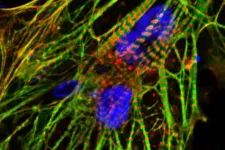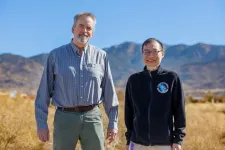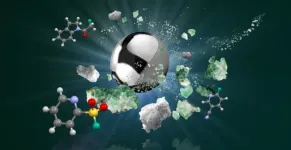(Press-News.org) Researchers at the University of Illinois Chicago have identified a process by which enzymes can help prevent heart damage in chemotherapy patients.
The enzymes are normally found in a cell’s mitochondria, the powerhouse that produces energy. But when heart cells are put under stress from certain types of chemotherapy drugs, the enzymes move into the cell’s nucleus, where they are able to keep the cells alive. The paper is published in Nature Communications.
“As chemotherapy has become more and more effective, we have more and more cancer survivors. But the tragic part is that a lot of these survivors now have problems with heart failure,” explained co-senior author Sang Ging Ong, assistant professor of pharmacology and medicine.
This has led to the rise of a field called cardio-oncology. Most previous research in the field focused on the mechanisms by which chemotherapy drugs damaged the mitochondria of heart cells. This research team was interested in investigating a different angle: Why do some patients’ hearts escape damage? Is there something particular about their cells that is protecting them?
First the team discovered that when the heart cells were stressed by chemotherapy, the mitochondrial enzymes moved into the cell’s nucleus — an unusual phenomenon. But they didn’t know if that movement was the cause of the cell’s damage or the means of its protection, explained Dr. Jalees Rehman, co-senior author, Benjamin Goldberg Professor and head of the UIC Department of Biochemistry and Molecular Genetics.
“We really didn’t know which way it would go,” he said.
To find out, the researchers generated versions of the enzymes that would specifically move into the nucleus and bypass the mitochondria. They discovered that this relocation fortified the cells, keeping them alive. They demonstrated that this process worked in both heart cells generated from human stem cells and in mice exposed to chemotherapy.
“This seems to be a new mechanism by which heart cells can defend themselves against chemotherapy damage,” said Rehman, who is also a member of the University of Illinois Cancer Center.
The discovery suggests new clinical possibilities. Doctors could test individual patients to see if heart cells generated from personalized stem cells would adequately protect themselves from chemotherapy by moving their enzymes from their mitochondria into the cell’s nucleus. Doctors could draw blood from the patient, make stem cells from the blood cells and then use those personalized stem cells to generate heart cells with the same genetic makeup as the patient’s heart cells.
“Assessing the injury caused by chemotherapy and the enzyme movement from the mitochondria into the nucleus of those heart cells in a lab would help determine what the patient’s likely response would be to chemotherapy,” Rehman said.
In patients with inadequate protection, one could then enhance the protection by increasing the enzyme movement and protection of the heart cells.
The researchers are eager to do more studies looking at whether this method could help prevent heart damage from other conditions, such as high blood pressure and heart attacks, and whether it would work in other cells, such as those in blood vessels.
The other authors on the paper are Shubhi Srivastava, Priyanka Gajwani, Jordan Jousma, Hiroe Miyamoto, Youjeong Kwon, Arundhati Jana, Peter Toth and Gege Yan, all at UIC’s College of Medicine. The research was funded by grants from the National Institutes of Health and the American Heart Association.
Written by Emily Stone
END
Powerhouse proteins protect heart cells from chemotherapy damage
2023-07-20
ELSE PRESS RELEASES FROM THIS DATE:
New theory better explains how the brain stores memories
2023-07-20
How useful a memory is for future situations determines where it resides in the brain, according to a new theory proposed by researchers at HHMI"s Janelia Research Campus and collaborators at UCL.
The theory offers a new way of understanding systems consolidation, a process that transfers certain memories from the hippocampus – where they are initially stored – to the neocortex -- where they reside long term.
Under the classical view of systems consolidation, all memories move from the hippocampus to the neocortex over time. But this view doesn’t always hold up; research shows some memories permanently reside ...
Draining 401(k) accounts when changing jobs: the hidden time bomb undermining retirement savings
2023-07-20
Key Takeaways:
At job separation, 41.4% of employees cash out 401(k) savings, most draining their entire accounts.
Cashing out increases with the proportion of the 401(k) balance contributed by employers. The “account composition effect” is most likely driven by behavioral rather than economic explanations.
The cash-out option was presented to terminating employees in a salient way, unintentionally nudging them to withdraw their 401(k) savings.
BALTIMORE, MD, July 17, 2023 – When researchers set out to study 401(k) retirement savings ...
Hubble sees boulders escaping from asteroid dimorphos
2023-07-20
The popular 1954 rock song "Shake, Rattle and Roll," could be the theme music for the Hubble Space Telescope's latest discovery about what is happening to the asteroid Dimorphos in the aftermath of NASA's DART (Double Asteroid Redirection Test) experiment. DART intentionally impacted Dimorphos on September 26, 2022, slightly changing the trajectory of its orbit around the larger asteroid Didymos.
Astronomers using Hubble's extraordinary sensitivity have discovered a swarm of boulders that were possibly shaken off the asteroid when NASA deliberately slammed the half-ton DART impactor spacecraft into Dimorphos ...
The American Society for Nutrition appoints Xingen Lei, Ph as next editor-in-chief of The Journal of Nutrition
2023-07-20
Rockville, MD (July 20, 2023) Xingen Lei, PhD, professor of molecular nutrition and associate dean of research and innovation at Cornell University’s College of Agriculture and Life Sciences, has been named the next editor-in-chief of The Journal of Nutrition, effective January 1, 2024. Established in 1928, The Journal of Nutrition is the oldest journal devoted to publishing influential original research, reviews, and perspectives of molecular, cellular, animal, human, and population nutrition and mechanisms.
Dr. Lei has published extensively in The Journal of Nutrition ...
Sending the shoes back? How about this lovely gift card? Cross-selling can help retailers avoid lost revenue from returns
2023-07-20
https://www.rotman.utoronto.ca/Connect/MediaCentre/NewsReleases/20230720
Toronto - It’s become so darn easy to order stuff thanks to the miracles of online shopping. But it’s not so simple on the retailer end, especially when more than 16 per cent of those sales are later sent back. In the U.S., that adds up to a staggering $816 billion in lost revenue.
Cross-selling can help, say a pair of researchers. Their experiments show that once we’ve chosen to buy something, we tend to consider that money as already spent or gone, also called ...
ECOG-ACRIN adds a new treatment trial to the ComboMATCH precision medicine initiative
2023-07-20
The ECOG-ACRIN Cancer Research Group (ECOG-ACRIN) has enrolled the first patient in a new treatment trial to evaluate the effectiveness of adding nilotinib to standard paclitaxel chemotherapy. The trial (EAY191-E4) is for the treatment of adults with cancers that are getting worse after being treated with taxane-based chemotherapy. It is a new addition to the recently launched ComboMATCH precision medicine initiative, which uses tumor biology as a guiding point for testing new combinations of cancer drugs.
James M. Ford, MD, the ECOG-ACRIN Chair for ComboMATCH and Professor of Medicine (Oncology) and Genetics at Stanford University, ...
Climate science is catching up to climate change with predictions that could improve proactive response
2023-07-20
In Africa, climate change impacts are experienced as extreme events like drought and floods. Through the Famine Early Warning Systems Network (which leverages expertise from USG science agencies, universities, and the private sector) and the IGAD Climate Prediction and Applications Center, it has been possible to predict and monitor these climatic events, providing early warning of their impacts on agriculture to support humanitarian and resilience programming in the most food insecure countries of the world.
Science is beginning to catch up with and even ...
Detecting threats beyond the limits of human, sensor sight
2023-07-20
ALBUQUERQUE, N.M. — Remember what it’s like to twirl a sparkler on a summer night? Hold it still and the fire crackles and sparks but twirl it around and the light blurs into a line tracing each whirl and jag you make.
A new patented software system developed at Sandia National Laboratories can find the curves of motion in streaming video and images from satellites, drones and far-range security cameras and turn them into signals to find and track moving objects as small as one pixel. The developers say this system can enhance the performance of any remote sensing application.
“Being able to track each pixel from a distance matters, ...
Nature inspires breakthrough achievement: hazard-free production of fluorochemicals
2023-07-20
For the first time, Oxford chemists have generated fluorochemicals – critical for many industries – without the use of hazardous hydrogen fluoride gas.
The innovative method was inspired by the biomineralization process that forms our teeth and bones.
The results are published today in the leading journal Science.
A team of chemists have developed an entirely new method for generating critically important fluorochemicals that bypasses the hazardous product hydrogen fluoride (HF) gas. ...
Could early induction of labor reduce inequities in pregnancy outcomes?
2023-07-20
Inducing labor at 39 weeks of pregnancy has the greatest benefit in risk reduction for women from more socioeconomically deprived areas, according to a new study published July 13th in the open access journal PLOS Medicine by Ipek Gurol-Urganci of the London School of Hygiene & Tropical Medicine, UK, and colleagues. The findings suggest that increased uptake of induction of labor at 39 weeks may help reduce inequities in adverse perinatal outcomes.
Adverse perinatal outcomes— which include stillbirths, neonatal ...





